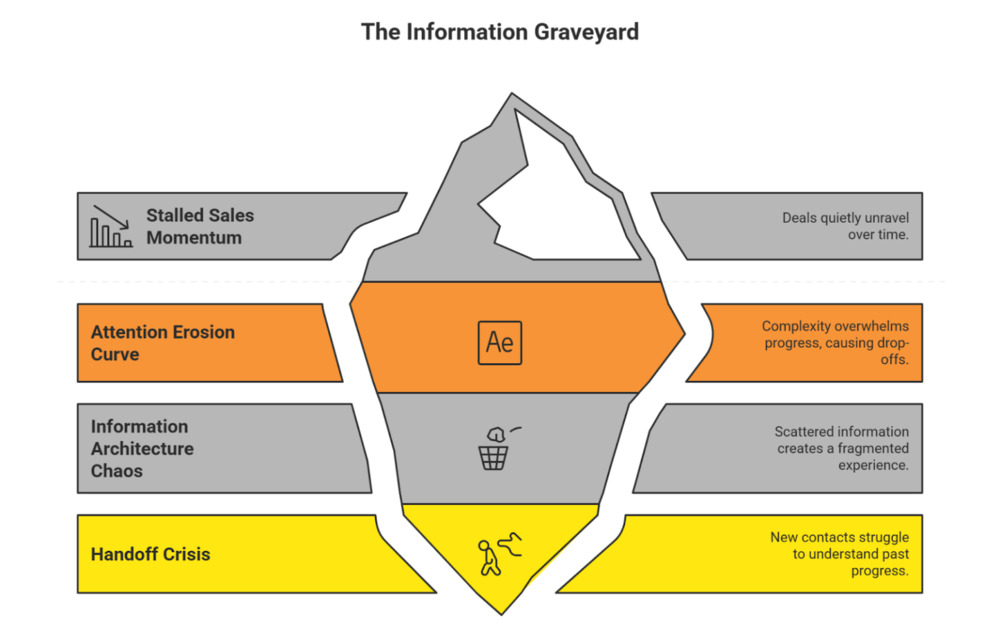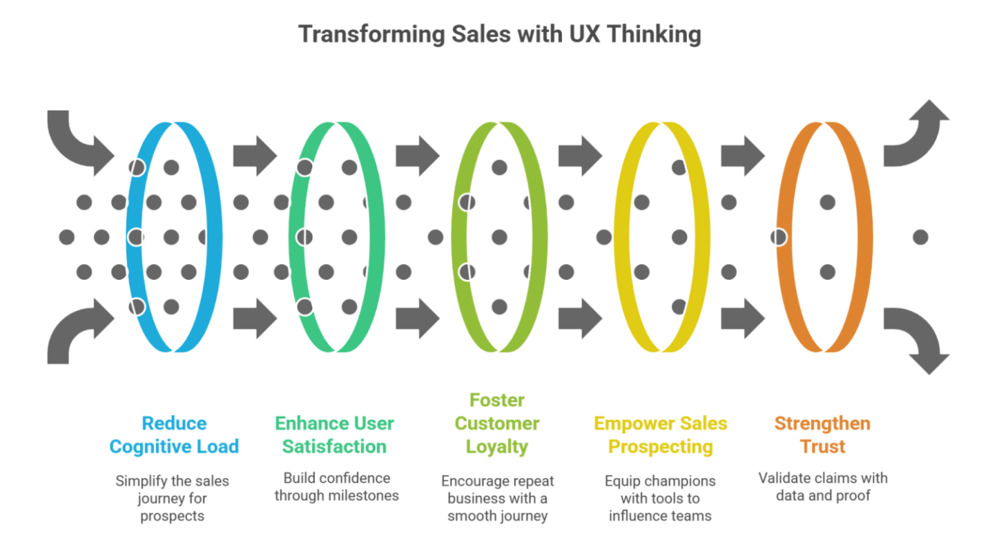Traditional B2B sales often revolve around a 30-day demo or a one-off proof of concept. The idea is simple: show the product, convince the buyer, then wait for them to sign.
The reality of a long sales cycle is far more complex.
The true change lies in regarding the B2B sales cycle as an extended form of user experience (UX) onboarding.
Instead of pushing content reactively, the aim is to design a continuous user experience that reduces cognitive load, empowers internal champions, and validates the choice step by step.
Designing this experience starts with data-driven design UX principles that reduce friction and guide prospects step by step
In other words, the sales process itself becomes a product worth designing.
Table of Contents
Why Traditional Sales Demos Fail in Extended Cycles

A brilliant software demo in January. By March, the original contact had moved to a different role.
In May, the new stakeholder asks you to explain everything again. By July, everyone’s forgotten why they even started this conversation.
This is the death spiral of long sales cycles.
Enterprise sales face a unique cognitive load problem. Your prospects juggle day jobs, internal politics, and the psychological burden of championing a potentially massive organisational change.
The 30-day proof of concept model simply cannot handle the complexity of real B2B sales cycle dynamics.
According to Gartner’s research on B2B buying, the typical buying group for a complex solution involves six to ten decision makers. Each person brings their own priorities, concerns, and ability to derail progress.
Your job through UX design is to make it ridiculously easy for your internal champion to keep everyone aligned, informed, and moving forward. Testing assumptions early with the right UX testing tools helps validate each milestone instead of waiting until the end.
The Information Graveyard: Chaos Kills Clarity

Every long B2B sales cycle has breaking points, critical moments where momentum stalls, priorities shift, and deals quietly unravel
a. The Attention Erosion Curve
Sales prospecting gets people in the door. Lead qualification identifies serious buyers. But somewhere around month three, momentum dies. Then again at month seven.
These aren’t random drop-off points. They represent moments when complexity overwhelms progress, when the cognitive burden becomes too heavy.
Think about the last time you started a complex project at work. Initial excitement fades fast when faced with:
- Scattered information across seventeen email threads
- No clear sense of progress
- Uncertainty about next steps
- Fear of making the wrong recommendation
Your prospects live in this state for months on end.
Many B2B teams solve this by pairing strong UX writing with a well-structured corporate website design that keeps progress clear and visible.
b. Information Architecture Chaos
Most sales cycles treat information like rubbish dumped into an overflowing bin. Proposal documents sit in shared drives. Technical specifications live in email attachments. Pricing discussions happen on calls that nobody documented properly.
When your champion needs to brief their CFO, they’re forced to become archaeologists, digging through fragments trying to piece together a coherent story.
This is terrible UX. Your CRM software might track this internally, but what about the prospect’s experience?
A content-first approach supported by content marketing ensures prospects always have structured, accessible information rather than scattered fragments.
c. The Handoff Crisis
Here’s a scenario that kills deals daily: Your main contact goes on parental leave. The replacement knows nothing about the six months of work that preceded them.
You’re essentially starting over, except now you’re doing it with someone who’s already sceptical about inheriting this massive project.
The handoff UX determines whether your deal survives personnel changes. If new stakeholders can’t immediately understand progress made, value demonstrated, and logical next steps, you’ve lost.
Consistent handoff experiences can also be reinforced through digital assets like video making and social media marketing that keep stakeholders aligned.
Design for Confidence: Building the Continuous Validation Loop
Rather than treating the sales cycle as sporadic touchpoints, design it as an integrated experience with clear feedback mechanisms.
This framework draws from product onboarding principles applied to sales enablement.
A. Micro-Progress and Proof Gamification
Break down your monolithic “Proof of Concept” into weekly, digestible chunks. Instead of “Prove our platform works” (overwhelming), structure it as:
- Week 1: Data integration validation
- Week 2: Role-based access control test
- Week 3: Custom workflow mapping
- Week 4: ROI validation against current state
Create a shared prospect dashboard that serves as a single source of truth. This isn’t about fancy customer relationship management platforms for your team.
Build something for them. Show progress completed, calculated savings to date, and logical next steps. Make the path forward crystal clear.
Salesforce has done this brilliantly with their Success Plans feature, allowing prospects to see exactly where they are in the evaluation journey. It transforms an abstract process into tangible forward motion.
B. Reverse Onboarding for Internal Champions
Your champion needs to sell internally. Give them the weapons to do it effectively.
Design collateral specifically for their stakeholders, including:
- a. Pre-made presentation decks tailored for CFOs, CIOs, and department heads. Each version emphasises different value propositions relevant to that audience. Your champion shouldn’t need to build these from scratch.
- b. Concise TL;DR summaries that busy executives can actually read. Think one-page overviews with clear ROI validation, testimonials from similar companies, and risk mitigation strategies.
- c. Pre-filled email templates that make it frictionless to loop in new stakeholders. For instance, “Hi Sarah, wanted to bring you into this conversation about [solution]. Here’s what we’ve validated so far…”
The goal is making your champion look brilliant internally. That’s lead nurturing done properly. Equipping champions with presentation-ready assets is part of what our digital marketing agency delivers, clarity tailored for every decision-maker.
C. The Sandbox Environment
Provide secure, personalised testing environments that feel like polished products, not cobbled-together lab experiments. Allow prospects to test with their own data subsets early in the cycle.
HubSpot’s demo environment approach exemplifies this.
Instead of long, technical walkthroughs, prospects can explore the platform on their own terms at any time, anywhere.
By using realistic data scenarios, users see exactly how the product works in action.This self-guided experience builds trust and confidence, while removing barriers that slow down the decision-making process.
Tactical Implementation That Actually Works
Strategy is great, but execution is better. Adopt these high-impact tactical implementations to transform how you communicate, handoff clients, and present pricing.
A. Asynchronous Communication Design
Email hampers deal progression; utilise collaboration tools such as personalised project portals for centralised information.
Notion, Coda, or organised shared workspaces are effective. Implement “expiring annotations” on demo links for timely, relevant notes that help avoid confusion later on.
B. Seamless Handoff Design
Create standardised “Prospect History Cards” that capture all prior conversations, tests conducted, stated priorities, and concerns addressed.
When new stakeholders enter the picture, or when your team transitions from sales to implementation, nobody should need to repeat themselves.
Professional services firms often struggle with this transition. The consultative selling phase feels disconnected from actual delivery. Bridge this gap through consistent documentation that travels with the prospect, not trapped in your internal systems.
C. Pricing Transparency UX
Decision fatigue in pricing hinders momentum. To alleviate this, create interactive ROI calculators for prospects to explore adjustable variables over time.
Use clear visual aids, such as comparison charts and sliders, to present tiered pricing. This clarity simplifies the purchase decision. Slack’s self-service pricing calculator exemplifies.
This approach, allowing enterprise buyers to model user counts and features without the need for calls, thereby reducing friction in evaluation.
We often pair pricing clarity with interactive Google Ads campaigns and LinkedIn Ads to ensure the right message reaches the right audience.
The Benefits: UX Thinking for the B2B Sales Cycle

Applying a UX mindset to your sales cycle transforms a complex, slow process into a streamlined journey that dramatically increases close rates and client confidence.
- Lower cognitive load prospects see progress and know the next step
- Higher user satisfaction each milestone reinforces confidence
- Improved customer loyalty a smooth journey makes repeat business easier
- Efficient sales prospecting champions are empowered with tools to influence their teams
- Stronger trust validation comes from data and shared proof, not just promises
To see how clarity-driven design improves ROI, explore our Newnormz portfolio of B2B projects.
Design Your Sales Pipeline to Close Deals 5X Faster
Long sales cycles involve a lengthy onboarding process where each interaction can build trust or create confusion.
Great products open doors, but well-crafted experiences close deals. Ones that make prospects feel involved and assured from start to finish.
When planning your enterprise sales cycle, consider whether it offers a polished experience or chaotic disorganisation, as this will affect the outcome.
Implementing a continuous validation loop helps streamline sales cycles into structured journeys with clear milestones, improving overall success and reducing deal loss due to internal confusion.
Ready to design your own validation loop? Contact Newnormz today and let’s build a B2B sales journey that closes faster and converts stronger.






